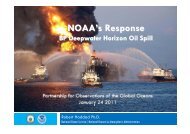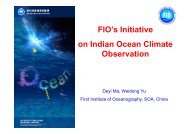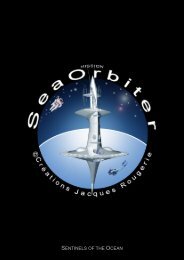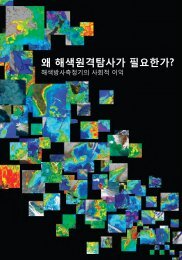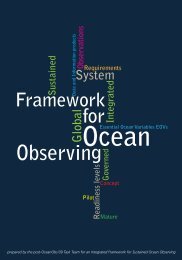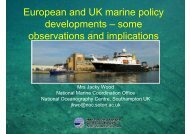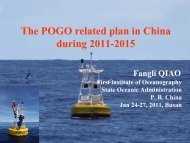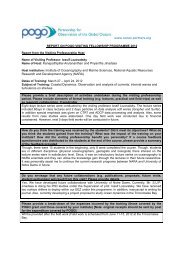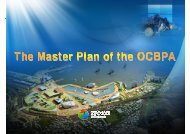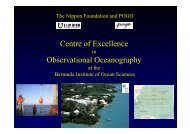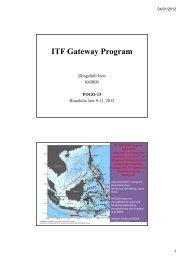NF-POGO Centre of Excellence Year 2 Report
NF-POGO Centre of Excellence Year 2 Report
NF-POGO Centre of Excellence Year 2 Report
- No tags were found...
Create successful ePaper yourself
Turn your PDF publications into a flip-book with our unique Google optimized e-Paper software.
fumes through her deck boards was a dreaded adventure. However, at the same time, it was excitinggoing to sea as a scientist and learning the rudiments <strong>of</strong> oceanographic sea-going equipment andinstrumentation. What a change to what you see today in terms <strong>of</strong> accommodations, ships,laboratories, and equipment that you have been able to use as <strong>POGO</strong>nian scholars at BIOS!In my early career, having the opportunity to work for Shell Oil Company and to work asStaff Geochemist and Assistant Director at BBSR enhanced my understanding <strong>of</strong> the Earth andocean sciences and broadened my scientific perspective. This paid <strong>of</strong>f in my future endeavors interms <strong>of</strong> being able to obtain grant support in both ocean and Earth sciences, and eventually climatescience, and to collaborate with scientists from several disciplines. My collaborators over the yearsnow number more than 200 individuals in many fields! It also prepared me for the teaching andcommunication enterprise part <strong>of</strong> my career, eventually leading to the creation <strong>of</strong> a new Bachelor <strong>of</strong>Science degree program in Global Environmental Science at the University <strong>of</strong> Hawaii.I would encourage all <strong>of</strong> you <strong>POGO</strong>nians, especially in this day and age, to continue to honeyour skills in mathematics and cognate science to provide you with the tools to interpret yourexperimental and field data on the basis <strong>of</strong> sound theory and modeling. This will also enable you tocommunicate more clearly and to form scientific collaborations with your colleagues in Earthscience and oceanography disciplines that may or may not be your specialty. In addition, it will helpto prepare you for future career changes and opportunities that inevitably will come your way. The<strong>POGO</strong> program alone has enabled you to expand your scientific and outreach horizons and willstand you in good stead for the future.Lesson # 2 can be difficult and one you might not want to hear and that is to work hard andlong. I learned this lesson early on but it was imprinted on me as a graduate student at LehighUniversity. Our department Chair at that time was Hugh Richard Gault who maintained what hecalled ―bed check‖. It may be difficult to believe but he would come into the laboratory at midnightor shortly thereafter every night to check on the graduate students to make sure they were stillworking. I did keep a sleeping s<strong>of</strong>a in my <strong>of</strong>fice for just those occasions. Our workweek was likethat <strong>of</strong> medical doctors in residency for four to six years. This made quite an impression on me. Ilearned early that science is a hard and generally unforgiving taskmaster and to succeed you have toput the time and effort into it. I conveyed this to all my graduate students and, like Dr. Andersson, Ithink they listened!! I would also encourage you <strong>POGO</strong>nians to spend the time and effort wiselyand judiciously to solve the problems <strong>of</strong> the oceans.Lesson # 3 is one we learn early on as scientists--be a skeptic. I remember early in mycollege career while taking courses in scientific philosophy and methodology that the Irish physicistand geologist John Joly had calculated the age <strong>of</strong> the oceans in 1899 to be 80 to 100 million yearsbased on the input <strong>of</strong> salts to the sea by rivers and the amount <strong>of</strong> salt in the sea. Fortunately therewere skeptics around like the Dutch geochemist and mineralogist Willem Nieuwenkamp whopointed out that the salts <strong>of</strong> the sea recycle through the atmosphere and sediments <strong>of</strong> the sea floorand the age <strong>of</strong> the Earth and oceans must be much more, as was required by the 1859 evolutionarytheory <strong>of</strong> Charles Darwin.In a less dramatic sense, in the early 1960s in my days at Bermuda, I was developing aresearch program studying the calcareous deposits <strong>of</strong> Bermuda as an indicator <strong>of</strong> sea level changesduring the Late Pleistocene and looking at the processes controlling strontium concentrations andvertical gradients in the ocean <strong>of</strong>fshore Bermuda. The latter work was an eye-opener. First I



